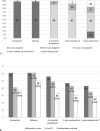Pregnancy Outcomes Among Perinatally HIV-Infected Women in Spain
- PMID: 36215978
- PMCID: PMC9592160
- DOI: 10.1097/QAI.0000000000003070
Pregnancy Outcomes Among Perinatally HIV-Infected Women in Spain
Abstract
Background: An increasing number of women living with perinatally acquired HIV are reaching adulthood and becoming pregnant. Achieving viral suppression is challenging in this population frequently exposed to numerous antiretroviral regimens. This study describes the long-term outcomes of pregnant women living with perinatally acquired HIV in Spain.
Methods: Descriptive, retrospective, multicenter study of the women living with perinatally acquired HIV who gave birth between January 2000 and December 2019 in Madrid. Epidemiological, clinical, and HIV-related data were collected from the first delivery to the end of the study period, including antiretroviral therapy, prevention strategies, and outcomes.
Results: Sixty-three live births in 33 women were included. The mean number of pregnancies per women was 1.9 (range: 1-6). At first delivery, women's median age was 20 years (interquartile range: 18-23), 11 (33.3%) had been previously diagnosed with AIDS and 6 (18%) with mental health disorders. Forty percent became pregnant unsuppressed, whereas 81% achieved viral suppression at delivery. Treatment interruptions were common after delivery, as were losses to follow-up, with no positive effect of pregnancy on retention to care or the immune virological situation. Five women (15%) experienced a new AIDS event, and there were 2 deaths (6%) during follow-up. There was 1 case of mother-to-child transmission in a nonadherent woman in whom preventive measures could not be implemented.
Conclusions: Pregnancy in this unique population of women living with perinatally acquired HIV poses particular challenges. Specific strategies, including a multidisciplinary approach, are needed to minimize perinatal transmission risks and improve outcomes during the postpartum period.
Copyright © 2022 The Author(s). Published by Wolters Kluwer Health, Inc.
Conflict of interest statement
The authors have no conflicts of interest to disclose.
Figures


References
-
- Aguilera-Alonso D, Sainz T, Jimenez de Ory S, et al. Clinical, immunological, and virological outcomes among youths with perinatal HIV after transition to adult units in Spain from 1997 to 2016. J Acquir Immune Defic Syndr. 2021;86:240–247. - PubMed
-
- Millery M, Vazquez S, Walther V, et al. Pregnancies in perinatally HIV-infected young women and implications for care and service programs. J Assoc Nurses AIDS Care. 2012;23:41–51. - PubMed
-
- Cruz ML, Cardoso CA, João EC, et al. Pregnancy in HIV vertically infected adolescents and young women: a new generation of HIV-exposed infants. AIDS. 2010;24:2727–2731. - PubMed
-
- Kenny J, Williams B, Prime K, et al. Pregnancy outcomes in adolescents in the UK and Ireland growing up with HIV. HIV Med. 2012;13:304–308. - PubMed
Publication types
MeSH terms
Substances
LinkOut - more resources
Full Text Sources
Medical

